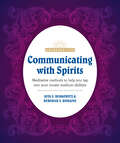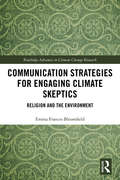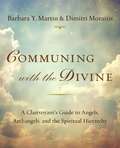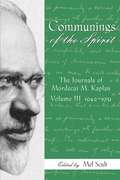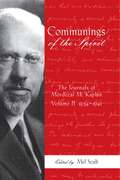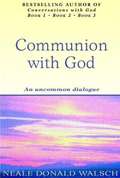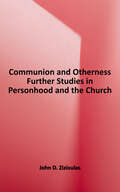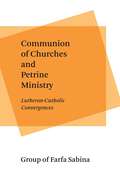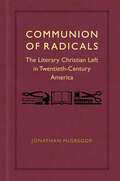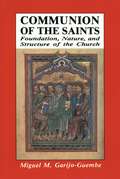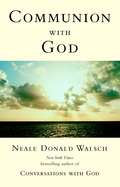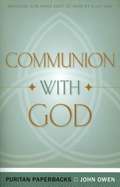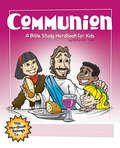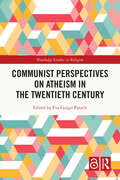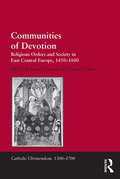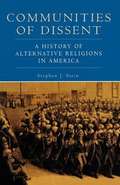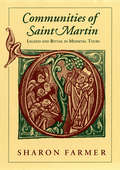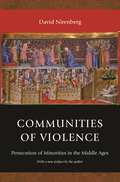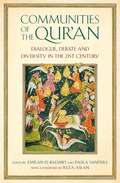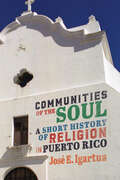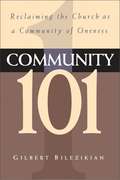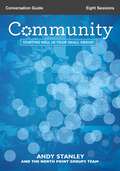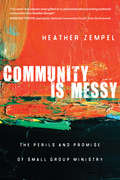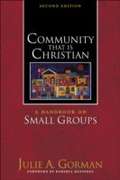- Table View
- List View
Communicating with Spirits: Meditative Methods to Help You Tap Into Your Innate Medium Abilities (The Awakened Life)
by Deb Baker Rita BerkowitzYou know there's more to life than physical existenceLife is a journey and physical birth and death are its points of transition. Many people across multiple cultures and faith systems believe that the spirit lives on--and have experienced contact with the spirits of loved ones who have passed to the higher side. This contact is joyous, comforting, and healing--but you wonder if it's actually real and whether you can share in it, too. This enlightening guide will show you exactly how to uncover your own mediumistic capabilities and connect with those no longer on your plane. In this new and improved edition, you'll find:Tips on how to connect with your divine energy through prayer, meditation, and dreams.Information on the birth of the human soul as perceived through multiple viewpoints.Exercises to help you develop your mediumistic abilities.Helpful ways to interpret and understand the symbolism of spiritual communication.Instruction on how to explore your past lives and to examine your auraDon't give up the spirit!
Communication Strategies for Engaging Climate Skeptics: Religion and the Environment (Routledge Advances in Climate Change Research)
by Emma Frances BloomfieldCommunication Strategies for Engaging Climate Skeptics examines the intersection of climate skepticism and Christianity and proposes strategies for engaging climate skeptics in productive conversations. Despite the scientifically established threats of climate change, there remains a segment of the American population that is skeptical of the scientific consensus on climate change and the urgent need for action. One of the most important stakeholders and conversants in environmental conversations is the religious community. While existing studies have discussed environmentalism as a factor within the religious community, this book positions religion as an important factor in environmentalism and focuses on how identities play a role in environmental conversation. Rather than thinking of religious skeptics as a single unified group, Emma Frances Bloomfield argues that it is essential to recognize there are different types of skeptics so that we can better tailor our communication strategies to engage with them on issues of the environment and climate change. To do so, this work breaks skeptics down into three main types: "separators," "bargainers," and "harmonizers." The book questions monolithic understandings of climate skepticism and considers how competing narratives such as religion, economics, and politics play a large role in climate communication. Considering recent political moves to remove climate change from official records and withdraw from international environmental agreements, it is imperative now more than ever to offer practical solutions to academics, practitioners, and the public to change the conversation. To address these concerns, this book provides both a theoretical examination of the rhetoric of religious climate skeptics and concrete strategies for engaging the religious community in conversations about the environment. This book will be of great interest to students, scholars, and practitioners of climate change science, environmental communication, environmental policy, and religion.
Communing with the Divine
by Barbara Y. MartinThe Angelic Keys to Fulfilling Your Life's Purpose. In their newest book, award-winning authors Barbara Y. Martin and Dimitri Moraitis explore the sacred art of communing with celestial beings. Reading of Martin's extensive direct clairvoyant experiences, this book will teach you to work closely with angels, archangels, and other divine beings who guide you in day-to-day living and help you achieve your destiny. You will learn how to strengthen your intuitive powers and hear what the divine is telling you, and thrill to accounts of Martin's compelling personal encounters with celestial beings and her eye-opening encounters with dark spirits. Communing with the Divine is a practical training manual and an inspirational guide, with full-color illustrations of celestial beings and their auric composition. In it, you will discover:**Various types of angels, including joy guides, teaching angels, and guardian angels*Techniques to call on Michael, Gabriel, Uriel, Raphael, and other archangels*Ways in which leaders of the spiritual hierarchy influence your life*The nature of evil and the importance of spiritual protection*Keys to psychic and spiritual visions and clairvoyance*Meditation tools to access celestial realms with more than fifty meditative prayers that call on Divine Light and celestial beings for wisdom, love, prosperity, healing, peace, guidance, inspiration, and much more
Communings of the Spirit, Volume III: The Journals of Mordecai M. Kaplan, 1942-1951 (American Jewish Civilization Ser.)
by Mordecai M. Kaplan Daniel G. CedarbaumMordecai M. Kaplan (1881–1983), founder of Reconstructionism and the rabbi who initiated the first Bat Mitzvah, also produced the longest Jewish diary on record. In twenty-seven volumes, written between 1913 and 1978, Kaplan shares not only his reaction to the great events of his time but also his very personal thoughts on religion and Jewish life. In Communings of the Spirit: The Journals of Mordecai M. Kaplan Volume III, 1942–1951, readers experience his horror at the persecution of the European Jews, as well as his joy in the founding of the State of Israel. Above all else, Kaplan was concerned with the survival and welfare of the Jewish people. And yet he also believed that the well-being of the Jewish people was tied to the safety and security of all people. In his own words, "Such is the mutuality of human life that none can be saved, unless all are saved." In the first volume of Communings of the Spirit, editor Mel Scult covers Kaplan’s early years as a rabbi, teacher of rabbis, and community leader. In the second volume, readers experience the economic problems of the 1930s and their shattering impact on the Jewish community. The third volume chronicles Kaplan’s spiritual and intellectual journey in the 1940s. With candor and vivid detail, Kaplan explores his evolving beliefs concerning a democratic Judaism; religious naturalism; and the conflicts, uncertainties, and self-doubts he faced in the first half of the twentieth century, including his excommunication by the ultra-Orthodox in 1945 for taking a more progressive approach to the liturgy. In his publications, Kaplan eliminated the time-honored declarations of Jewish chosen-ness as well as the outdated doctrines concerning the resurrection of the dead. He wanted a prayer book that Jews could feel reflected their beliefs and experiences; he believed that people must mean what they say when they pray. Kaplan was a man of contradictions, but because of that, all the more interesting and significant. Scholars of Judaica and rabbinical studies will value this honest look at the preeminent American Jewish thinker and rabbi of our times.
Communings of the Spirit: 1934–1941 (American Jewish Civilization Ser.)
by Mel ScultMordecai M. Kaplan (1881-1983), founder of Reconstructionism, is the preeminent American Jewish thinker and rabbi of our times. His life embodies the American Jewish experience of the first half of the twentieth century. With passionate intensity and uncommon candor, Kaplan compulsively recorded his experience in his journals, some ten thousand pages. At times, Kaplan thought his ideas were too radical or complex to share with his congregation. What he could not share publicly he put into his journals. In this diary we find his uncensored thoughts on a variety of subjects. Thus, the diary was much more sophisticated and radical than anything he published while living. While in the first volume of Communings of the Spirit, editor Mel Scult covers Kaplan's early years as a rabbi, teacher of rabbis, and community leader, in the second volume we experience through Kaplan the economic problems of the 1930s and their shattering impact on the Jewish community. It becomes clear that Kaplan, like so many others during this period, was attracted to the solutions offered by communism, notwithstanding some hesitation because of the anti-religious nature of communist ideology. Through Kaplan we come to understand the Jewish community in the yishuv (Jews in Palestine) as Kaplan spent two years teaching at the Hebrew University in Jerusalem and his close circle of friends included Martin Buber, Judah Leon Magnes, and other prominent personalities. It is also during this time that the specter of Nazi Germany begins to haunt American Jews, and Kaplan, sensitive to the threats, is obsessed with Jewish security, both in Europe and Palestine. More than anything else, this diary is the chronicle of Kaplan's spiritual and intellectual journey in the early 1930s and 1940s. With honesty and vivid detail, Kaplan explores his evolving beliefs on religious naturalism and his uncertainties and self-doubts as he grapples with a wide range of theological issues.
Communion With God: An uncommon dialogue
by Neale Donald WalschSix years ago, Neale Donald Walsch began a conversation - forging his own unique relationship with God - and the result was "Conversations with God" book 1, which has sold over 2 million copies worldwide. In that inspirational series, Neale Donald Walsch showed that it is up to us to begin our own conversation. The next stage, as he explained in "Friendship with God", is to take this relationship one step further. Now, with the final book in this incredible series, we learn how to take the ultimate step towards communion with god.
Communion and Otherness: Further Studies in Personhood and the Church
by John D. ZizioulasIn this wide-ranging study, the distinguished Orthodox theologian, Metropolitan John (Zizioulas) of Pergamon, seeks to answer that question. In his celebrated book, Being as Communion (1985), he emphasized the importance of communion for life and for unity. In this important companion volume, he now explores the complementary fact that communion is the basis for true otherness and identity. With a constant awareness of the deepest existential questions of today, Metropolitan John probes the Christian tradition and highlights the existential concerns that already underlay the writings of the Greek fathers and the definitions of the early ecumenical councils. In a vigorous and challenging way, he defends the freedom to be other as an intrinsic characteristic of personhood, fulfilled only in communion. <p><p>After a major opening chapter on the ontology of otherness, written especially for this volume, the theme is systematically developed with reference to the Trinity, Christology, anthropology, and ecclesiology. Another new chapter defends the idea that the Father is the cause of the Trinity, as taught by the Cappadocian fathers, and replies to criticisms of this view. The final chapter responds to the customary separation of ecclesiology from mysticism and strongly favors a mystical understanding of the body of Christ as a whole. Other papers, previously published but some not easily obtainable, are all revised for their inclusion here. This is a further contribution to the dialogue on some of the most vital issues for theology and the Church from one of the leading figures in modern ecumenism.
Communion of Churches and Petrine Ministry: Lutheran-Catholic Convergences
by Group of Farfa SabinaCatholic Books Review "An excellent scholarly overview of convergences between Lutheran and Catholic theologians and some promising developments between the churches."William G. Rusch — Yale Divinity School "This work is an indispensable resource for anyone interested in overcoming the disunity of the churches. It demonstrates how high-quality scholarship can enlighten questions about the papacy that at first glance appear closed. Disclosing the potential for degrees of resolution to what were once regarded as intractable barriers to greater unity, this report cannot be recommended too highly."John A. Radano — Seton Hall University "A significant contribution to promoting ecumenical advance, this book is a must-read for those interested in the work of reconciliation among divided Christians."
Communion of Radicals: The Literary Christian Left in Twentieth-Century America
by Jonathan McGregorPopular perceptions of American writers as either godless radicals or God-fearing reactionaries overlook a vital tradition of Christian leftist thought and creative work. In Communion of Radicals, Jonathan McGregor offers the first literary history of theologically conservative writers who embraced political radicalism, as their reverence for tradition impelled them to work for social justice. Challenging recent accounts that examine twentieth-century American literature against the backdrop of the rising Religious Right, Communion of Radicals uncovers a different literary lineage in which allegiance to religious tradition fostered dedication to a more just future.From the Gilded Age to the Great Depression to the civil rights movement, traditional faith empowered the rebellious writing of socialists, anarchists, and Catholic personalists such as Vida Scudder, Dorothy Day, Claude McKay, F. O. Matthiessen, and W. H. Auden. By recovering their strain of traditioned radicalism, McGregor shows how strong faith in the past can fuel the struggle for an equitable future. As Christian socialists, Scudder and Ralph Adams Cram envisioned their movement for beloved community as a modern version of medieval monasticism. Day and the Catholic Workers followed the fourteenth-century example of St. Francis when they lived and wrote among the disaffected souls on the Bowery during the Great Depression. Tennessee’s Fellowship of Southern Churchmen argued for a socialist and antiracist understanding of the notion of “the South and the Agrarian tradition” popularized by James McBride Dabbs, Walker Percy, and Wendell Berry. Agrarian roots flowered into creative expressions encompassing the queer and Black medievalist poetry of Auden and McKay, respectively; Matthiessen’s Catholic socialist interpretation of the American Renaissance; and the genteel anarchism of Percy’s southern comic novels. Imaginative writing enabled these Christian leftists to commune with the past and with each other, driving their radical efforts in the present.Communion of Radicals chronicles a literary Christian left that unites deeply traditional faith with radicalism, and offers a usable past that disrupts perceived alignments of religion and politics.
Communion of the Saints: Foundation, Nature and Structure of the Church
by Miguel M. Garijo-GuembeModern Roman Catholic ecclesiology is best presented and understood as the complementary intertwining of pneumatology and Christology. This is the position of Lumen gentium and the Vision of Church the author explains and explores in this work. The author's central thesis is an ecclesiology built around the notion of communio: al Church members carry out their respective responsibilities toward the Church at al levels. Beginning with Scripture, the foundation of al theological reflection, the author asks: What ecclesiological perspectives can be found in the New Testament? Next, a systematic treatment of the nature of the Church, its structures (communities and offices), and the Church's mission (evangelization, the relationship between Church and society) reveals a universal Church centered in a community of local churches. A bibliography 'international in its authorship and ecumenical in its contributor's confessional backgrounds 'completes each chapter.
Communion with God
by Neale Donald WalschNeale Donald Walsch has changed the way the world thinks about God. His books have been translated into twenty-five languages, and his Conversations with God series, book 1, book 2, and book 3, have all been New York Times bestsellers-book 1 for over two years.<P> In the Conversations books, Walsch shared with his readers the beginning of a sacred relationship, as he began an exchange with God on everything from love and faith, to life and death, and good and evil. And then, as Walsch recounted in Friendship with God, something else extraordinary began to happen. His relationship with God began to strengthen and deepen, just as our own relationships do, into a friendship.<P> Now in Communion with God, his most richly intimate book yet, Walsh discovers how to elevate that friendship to a state of communion. In this blueprint for seekers, he reveals The Ten Illusions of Man—the misconceptions we hold about ourselves and our world and our God. He describes with striking clarity how we might heal the great divide that has arisen from these illusions. And as he explores the true meaning of bringing God into our everyday lives, of having the courage of our convictions, Walsch shows us that we can only break free from our illusions when we act always from a place of deep fellowship with all that is holy—a place of communion with God.
Communion with God (Abridged)
by John Owen R. J. LawDr. R. J. K. Law has produced a splendidly readable abridgment of one of the greatest Christian classics of all time, bringing Owen's rich teaching to a much wider readership.
Communion: A Bible Study Wordbook For Kids
by Richard E. ToddPerfect for use in Sunday school, Bible clubs, midweek programs, and even at home with a parent, this wordbook study on communion introduces children to the Lord&’s Supper and its meaning.The book illustrates the history of communion, how it is done, and why. It also explains when a child may go to communion: when their spiritual maturity has reached a point when the experience of communion can be fully appreciated. Activities include a maze, hidden bread and cup activity, coloring page, and secret message. This wordbook, designed especially for kids in grades 2–5, complements the rest of the Children&’s Wordbook series. They are great resources for parents and teachers who want to teach children the Christian doctrines of salvation, baptism, communion, giving, and theChurch.
Communion: A Bible Study Wordbook For Kids
by Richard E. ToddPerfect for use in Sunday school, Bible clubs, midweek programs, and even at home with a parent, this wordbook study on communion introduces children to the Lord&’s Supper and its meaning.The book illustrates the history of communion, how it is done, and why. It also explains when a child may go to communion: when their spiritual maturity has reached a point when the experience of communion can be fully appreciated. Activities include a maze, hidden bread and cup activity, coloring page, and secret message. This wordbook, designed especially for kids in grades 2–5, complements the rest of the Children&’s Wordbook series. They are great resources for parents and teachers who want to teach children the Christian doctrines of salvation, baptism, communion, giving, and theChurch.
Communist Perspectives on Atheism in the Twentieth Century (Routledge Studies in Religion)
by Eva Guigo-PatzeltThis book offers an analysis of the wide range of attitudes that communist movements and regimes adopted towards atheism during the 20th century. Despite the well-known violent fight of the Bolsheviks against believers, for example, and religious persecution in communist regimes at different times, being a communist did not always go hand in hand with being an atheist oneself or with the will to actively spread atheism. The reasons for the changing links between communism and atheism, ranging from militant atheists to communists presenting themselves as defenders of the authentic religion, deserved precise, in-depth investigation. The book’s case studies on Greece, Albania, Italy, Czechoslovakia, East Germany, Slovenia, Afghanistan, and Vietnam and its common focus on the causes of atheism will be of interest to scholars of these areas but also of atheism and secularism, religion, and politics.The Open Access version of this book, available at http://www.taylorfrancis.com, has been made available under a Creative Commons-Attribution-Non Commercial-No Derivatives (CC BY-NC-ND) 4.0 license.
Communities of Devotion: Religious Orders and Society in East Central Europe, 1450–1800 (Catholic Christendom, 1300-1700)
by Maria CraciunBetween the later middle ages and the eighteenth century, religious orders were in the vanguard of reform movements within the Christian church. Recent scholarship on medieval Europe has emphasised how mendicants exercised a significant influence on the religiosity of the laity by actually shaping their spirituality and piety. In a similar way for the early modern period, religious orders have been credited with disseminating Tridentine reform, training new clergy, gaining new converts and bringing those who had strayed back into the fold. Much about this process, however, still remains unknown, particularly with regards to east central Europe. Exploring the complex relationship between western monasticism and lay society in east central Europe across a broad chronological timeframe, this collection provides a re-examination of the level and nature of interaction between members of religious orders and the communities around them. That the studies in this collection are all located in east central Europe - Transylvania, Hungary, Austria, and Bohemia- fulfils a second key aim of the volume: the examination of clerical and lay piety in a region of Europe almost entirely ignored by western scholarship. As such the volume provides an important addition to current scholarship, showcasing fresh research on a subject and region on which little has been published in English. The volume further contributes to the reintegration of eastern and western European history, expanding the existing parameters of scholarly discourse into late medieval and early modern religious practice and piety.
Communities of Dissent: A History of Alternative Religions in America
by Stephen J. SteinAlternative religious groups have had a profound influence on American history--they have challenged the old and opened up new ways of thinking about healing, modes of meaning, religious texts and liturgies, the social and political order, and the relationships between religion and race, class,gender, and region. Virtually always, the dramatic, dynamic history of alternative religions runs parallel to that of dissent in America. Communities of Dissent is an evenhanded and marvelously lively history of New Religious Movements in America. Stephen J. Stein describes the evolution and structure of alternative religious movements from both sides: the critics and the religious dissenters themselves. Providing a fascinating look at a wide range of New Religious Movements, he investigates obscure groups such as the 19th-century Vermont Pilgrims, who wore bearskins and refused to bathe or cut their hair, alongside better-known alternative believers, including colonial America's largest outsider faith, the Quakers; 17th- and18th-century Mennonites, Amish, and Shakers; and the Christian Scientists, Jehovah's Witnesses, Black Muslims, and Scientologists of today. Accessible and comprehensive, Communities of Dissent also covers the milestones in the history of alternative American religions, from the infamous Salem witch trials and mass suicide/murder at Jonestown to the positive ways in which alternative religions have affected racial relations, the empowerment of women, and American culture in general.
Communities of Saint Martin: Legend and Ritual in Medieval Tours
by Sharon FarmerSharon Farmer here investigates the ways in which three medieval communities—the town of Tours, the basilica of Saint-Martin there, and the abbey of Marmoutier nearby—all defined themselves through the cult of Saint Martin. She demonstrates how in the early Middle Ages the bishops of Tours used the cult of Martin, their fourthcentury predecessor, to shape an idealized image of Tours as Martin's town. As the heirs to Martin's see, the bishops projected themselves as the rightful leaders of the community. However, in the late eleventh century, she shows, the canons of Saint-Martin (where the saint's relics resided) and the monks of Marmoutier (which Martin had founded) took control of the cult and produced new legends and rituals to strengthen their corporate interests.Since the basilica and the abbey differed in their spiritualities, structures, and external ties, the canons and monks elaborated and manipulated Martin's cult in quite different ways. Farmer shows how one saint's cult lent itself to these varying uses, and analyzes the strikingly dissimilar Martins that emerged. Her skillful inquiry into the relationship between group identity and cultural expression illuminates the degree to which culture is contested territory.Farmer's rich blend of social history and hagiography will appeal to a wide range of medievalists, cultural anthropologists, religious historians, and urban historians.
Communities of Violence: Persecution of Minorities in the Middle Ages - Updated Edition
by David NirenbergIn the wake of modern genocide, we tend to think of violence against minorities as a sign of intolerance, or, even worse, a prelude to extermination. Violence in the Middle Ages, however, functioned differently, according to David Nirenberg. In this provocative book, he focuses on specific attacks against minorities in fourteenth-century France and the Crown of Aragon (Aragon, Catalonia, and Valencia). He argues that these attacks--ranging from massacres to verbal assaults against Jews, Muslims, lepers, and prostitutes--were often perpetrated not by irrational masses laboring under inherited ideologies and prejudices, but by groups that manipulated and reshaped the available discourses on minorities. Nirenberg shows that their use of violence expressed complex beliefs about topics as diverse as divine history, kinship, sex, money, and disease, and that their actions were frequently contested by competing groups within their own society. Nirenberg's readings of archival and literary sources demonstrates how violence set the terms and limits of coexistence for medieval minorities. The particular and contingent nature of this coexistence is underscored by the book's juxtapositions--some systematic (for example, that of the Crown of Aragon with France, Jew with Muslim, medieval with modern), and some suggestive (such as African ritual rebellion with Catalan riots). Throughout, the book questions the applicability of dichotomies like tolerance versus intolerance to the Middle Ages, and suggests the limitations of those analyses that look for the origins of modern European persecutory violence in the medieval past.
Communities of the Qur’an: Dialogue, Debate and Diversity in the 21st Century
by Emran El-Badawi Paula SandersWhat is the nature of the Qur&’an? It might seem a straightforward question, but there is no consensus among modern communities of the Qur&’an, both Muslim and non-Muslim, about the answer. And why should there be? On numerous occasions throughout history, believers from different schools and denominations, and at different times and places, have agreed to disagree. The Qur&’anic interpreters, jurists and theologians of medieval Baghdad, Cairo and Cordoba coexisted peacefully in spite of their diverging beliefs. Seeking to revive this &‘ethics of disagreement&’ of Classical Islam, this volume explores the different relationships societies around the world have with the Qur&’an and how our understanding of the text can be shaped by studying the interpretations of others. From LGBT groups to urban African American communities, this book aims to represent the true diversity of communities of the Qur&’an in the twenty-first century, and the dialogue and debate that can flow among them.
Communities of the Soul: A Short History of Religion in Puerto Rico (McGill-Queen's Studies in the History of Religion)
by José E. IgartuaReligion is fundamental to contemporary Puerto Rican society. From the cosmology of the Indigenous Taíno, to the wide range of Judeo-Christian churches and sects, to the practitioners of spiritism, Afro-Caribbean religions, and witchcraft, religious practice in its many forms permeates the lives of most Puerto Ricans.Communities of the Soul illuminates the landscape and history of religion in Puerto Rico from the beliefs and practices of the Taíno to the religious diversity of the present day. Throughout its history, religion in Puerto Rico has braided institutional forms and popular practices, yet has always been a community-based process – made by the people. When the island was under Spanish colonial rule, the formal but weak presence of Catholicism meant that Puerto Ricans cultivated their religious experiences within families and local communities as much as within the structures of the church. These communal practices continued as Puerto Ricans joined Protestant denominations – particularly evangelical Pentecostalism – after the American conquest of the island in 1898. In the second half of the twentieth century, religious diversity increased with the formation of Jewish and Muslim communities, as well as numerous local evangelical congregations. Even as Puerto Rican society becomes more cosmopolitan and diverse, popular devotions and ritualistic practices remain an important part of everyday life.The first synthesis of the religious history of the island, Communities of the Soul is an innovative exploration of religion in Puerto Rico and the beliefs, practices, and diversity of its past and present.
Community 101
by Gilbert BilezikianAuthentic community is essential if the church is to remain true to its God-assigned mission. As the title indicates, the interrelated concepts of community and oneness are presented in this book. Gilbert Bilezikian lays a biblical foundation for this call to community by showing the centrality of community in the sweep of salvation history -- its loss in the Fall, its reclamation through Christ, and its ultimate realization in the New Jerusalem. Bilezikian proceeds to describe how community can be expressed in the daily life of the church, from small groups to various forms of ministry to church leadership. Focusing on oneness, this book presents a paradigm that can renew the vision of the church in this postmodern society and confirm the authenticity of its message. Authentic community is essential if the church is to remain true to its God-assigned mission. As the title indicates, the two interrelated concepts of community and oneness are presented in this book. Gilbert Bilezikian lays a biblical foundation for this call to community by showing the centrality of community in the sweep of salvation history - its loss in the Fall, its reclamation through Christ, and its ultimate realization in the New Jerusalem.
Community Conversation Guide: Starting Well in Your Small Group
by Andy Stanley Dan Mancini<P>Community. <P>It's a word we often hear, but what does it really mean? And why is it so important to your spiritual life? Because you can’t grow spiritually unless you’re connected relationally.<P> God designed us that way.<P> He wants to use other people to grow us and he wants to use us to grow other people.<P> In this 8-session video-based study (DVD/digital video sold separately), specifically designed for launching new small groups well, you’ll explore how building deep relationships with the people in your small group and serving in the larger community around you will grow your faith.<P> You’ll learn why your unique story matters… to God and to the people you do life with.<P> Community is a great way for small groups to grow together and for churches to connect new people in their congregation.<P> This conversation guide is a necessary tool walking you through each session with group starters, leader’s notes, discussion questions, and weekly reading.<P> Sessions include: Show Up Pursue God Join In Be Real Part 1 Be Real Part 2 Be Real Part 3 Be the Church Be Together Designed for use with Community Video Study (sold separately).
Community Is Messy: The Perils and Promise of Small Group Ministry
by Heather ZempelHeather Zempel oversees the community life at a multisite church in Washington, D.C., a challenging population with one of the highest relocation rates in the United States. And yet under her leadership, National Community Church has become a model for creative, dynamic, deep small group ministry. Drawing from her background as an environmental engineer (including such bizarre experiences as monitoring a pig lagoon and the unintended slaughter of a hundred innocent fish), Heather Zempel assesses the perils and possibilities inherent in small groups and other environments for Christian community. The book helps leaders begin to see the inherent "mess" of such gatherings as raw material for arriving at something beautiful. Read this book and discover fresh insights into how we can support one another's unique paths to maturity in Christ while maintaining cohesion as a community and blessing the world around us.
Community That is Christian: A Handbook on Small Groups (Second Edition)
by Julie GormanOver the past thirty years there has been a boom in small groups, both in society at large and within the church. From Bible studies to MOPS to Alcoholics Anonymous, it is estimated that four out of ten Americans belong to a small group that meets regularly for the care and support of its members. But are these groups creating true, biblical community, or do they settle for self-focus and personal gain? Julie Gorman has studied small groups for decades and presents her analysis, insights, and suggestions in Community That Is Christian, an essential resource for building community in church-based small groups. This comprehensive book serves both as a text for those who equip leaders or lead small groups and as an interactive manual for small-group members, helping them transform their relationships into Christ-centered community. The book begins with biblical support for coming together, contrasting it with our often individualistic mind-set that undermines community. Gorman then sets forth the goals of community and describes the process of transformation. She draws from extensive research to address the why and the how of small-group ministry, giving special attention to gender and cultural distinctions. Community That Is Christian provides readers with charts, discussion questions, and inventories to further help them establish community within their small groups.
